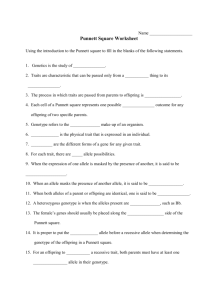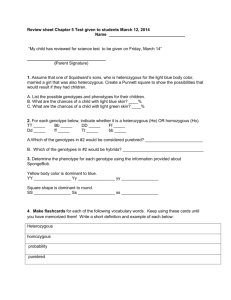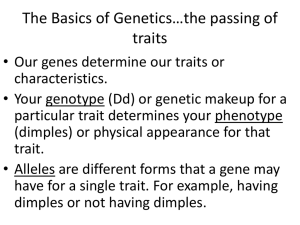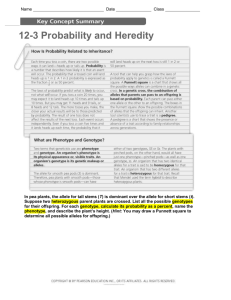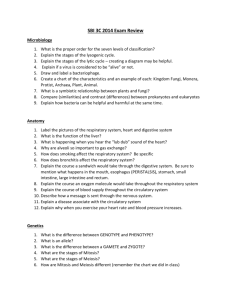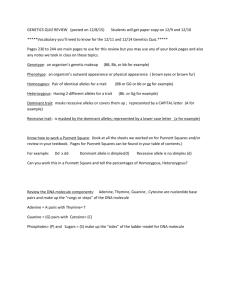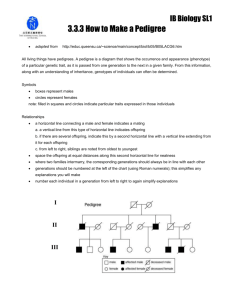dihybrid quiz to print
advertisement
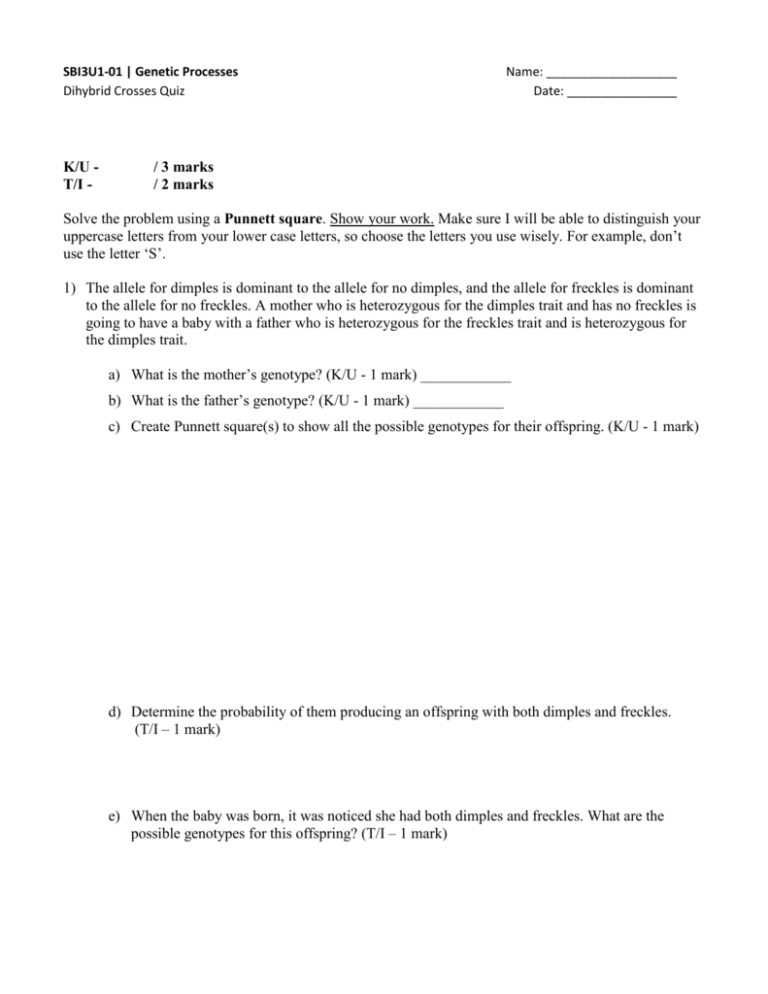
SBI3U1-01 | Genetic Processes Dihybrid Crosses Quiz K/U T/I - Name: ___________________ Date: ________________ / 3 marks / 2 marks Solve the problem using a Punnett square. Show your work. Make sure I will be able to distinguish your uppercase letters from your lower case letters, so choose the letters you use wisely. For example, don’t use the letter ‘S’. 1) The allele for dimples is dominant to the allele for no dimples, and the allele for freckles is dominant to the allele for no freckles. A mother who is heterozygous for the dimples trait and has no freckles is going to have a baby with a father who is heterozygous for the freckles trait and is heterozygous for the dimples trait. a) What is the mother’s genotype? (K/U - 1 mark) ____________ b) What is the father’s genotype? (K/U - 1 mark) ____________ c) Create Punnett square(s) to show all the possible genotypes for their offspring. (K/U - 1 mark) d) Determine the probability of them producing an offspring with both dimples and freckles. (T/I – 1 mark) e) When the baby was born, it was noticed she had both dimples and freckles. What are the possible genotypes for this offspring? (T/I – 1 mark) SBI3U1-02 | Genetic Processes Dihybrid Crosses Quiz K/U T/I - Name: ___________________ Date: ________________ / 3 marks / 2 marks Solve the problem using Punnett square(s). Show your work. Make sure I will be able to distinguish your uppercase letters from your lower case letters, so choose the letters you use wisely. For example, do not use the letter ‘S’. 1. The allele for short eye lashes is recessive to the allele for long eyelashes, and the allele for freckles is dominant to the allele for no freckles. A mother who is homozygous dominant for the eyelashes trait and heterozygous for the freckles trait is going to have a baby with a father who is heterozygous for the eyelashes trait and is heterozygous for the freckles trait. a) What is the mother’s genotype? (K/U - 1 mark) ____________ b) What is the father’s genotype? (K/U - 1 mark) ____________ c) Create Punnett square(s) to show all the possible genotypes for their offspring. (K/U - 1 mark) d) Determine the probability of them producing an offspring with long eyelashes and no freckles. (T/I – 1 mark) e) When the baby was born, it was noticed he had long eyelashes and no freckles. What are the possible genotype(s) for this offspring? (T/I – 1 mark) SBI3U1-04 | Genetic Processes Dihybrid Crosses Quiz K/U T/I - Name: ___________________ Date: ________________ / 3 marks / 2 marks Solve the problem using a Punnett square. Show your work. Make sure I will be able to distinguish your uppercase letters from your lower case letters, so choose the letters you use wisely. For example, do not use the letter ‘S’. 1) The allele for dimples is dominant to the allele for no dimples, and the allele for short eyelashes is recessive to the allele for long eyelashes. A mother who is homozygous recessive for the dimples trait and is heterozygous for the eyelashes trait is going to have a baby with a father who is heterozygous for the dimples trait and is heterozygous for the eyelashes trait. a) What is the mother’s genotype? (K/U - 1 mark) ____________ b) What is the father’s genotype? (K/U - 1 mark) ____________ c) Create Punnett square(s) to show all the possible genotypes for their offspring. (K/U - 1 mark) d) Determine the probability of them producing an offspring with both dimples and long eyelashes. (T/I – 1 mark) e) When the baby was born, it was noticed she had both dimples and long eyelashes. What are the possible genotypes for this offspring? (T/I – 1 mark) SBI3U1-06 | Genetic Processes Monohybrid Crosses Quiz CT/I - Name: ___________________ Date: ________________ / 2 marks / 3 marks Solve the problem using a Punnett square. Show your work. Make sure I will be able to distinguish your uppercase letters from your lower case letters, so choose the letters you use wisely. For example, don’t use the letter ‘S’. 1. In Dalmatians, spots are dominant to the condition of not having spots. a) A heterozygous, spotted male is mated with a heterozygous female. (K/U – 1 mark) What is the probability that these parents will produce a spotted pup? (T/I – 1 mark) b) A heterozygous, spotted male is mated with a homozygous recessive female. (K/U – 1 mark) What is the probability that these parents will produce a pup with no spots? (T/I – 1 mark) One of the pups that was born had no spots. What are the possible genotype(s) of this offspring? (T/I – 1 mark) SBI3U1-01 | Genetic Processes Dihybrid Crosses Quiz K/U T/I - Name: ___________________ Date: ________________ / 3 marks / 2 marks Solve the problem using a Punnett square. Show your work. Make sure I will be able to distinguish your uppercase letters from your lower case letters, so choose the letters you use wisely. For example, don’t use the letter ‘S’. 2) The allele for dimples is dominant to the allele for no dimples, and the allele for freckles is dominant to the allele for no freckles. A mother who is heterozygous for the dimples trait and has no freckles is going to have a baby with a father who is heterozygous for the dimples trait and is heterozygous for the freckles trait. f) What is the mother’s genotype? (K/U - 1 mark) Ddff g) What is the father’s genotype? (K/U - 1 mark) DdFf h) Create Punnett square(s) to show all the possible genotypes for their offspring. (K/U - 1 mark) i) Determine the probability of them producing an offspring with both dimples and freckles. (T/I – 1 mark) 3/8 or 37.5% j) When the baby was born, it was noticed she had both dimples and freckles. What are the possible genotypes for this offspring? (T/I – 1 mark) DDFf or DdFf SBI3U1-02 | Genetic Processes Dihybrid Crosses Quiz K/U T/I - Name: ___________________ Date: ________________ / 3 marks / 2 marks Solve the problem using Punnett square(s). Show your work. Make sure I will be able to distinguish your uppercase letters from your lower case letters, so choose the letters you use wisely. For example, do not use the letter ‘S’. 2. The allele for short eye lashes is recessive to the allele for long eyelashes, and the allele for freckles is dominant to the allele for no freckles. A mother who is homozygous dominant for the eyelashes trait and heterozygous for the freckles trait is going to have a baby with a father who is heterozygous for the eyelashes trait and is heterozygous for the freckles trait. f) What is the mother’s genotype? (K/U - 1 mark) EEFf g) What is the father’s genotype? (K/U - 1 mark) EeFf h) Create Punnett square(s) to show all the possible genotypes for their offspring. (K/U - 1 mark) i) Determine the probability of them producing an offspring with long eyelashes and no freckles. (T/I – 1 mark) ¼ or 25% j) When the baby was born, it was noticed he had long eyelashes and no freckles. What are the possible genotype(s) for this offspring? (T/I – 1 mark) EEff or Eeff SBI3U1-04 | Genetic Processes Dihybrid Crosses Quiz K/U T/I - Name: ___________________ Date: ________________ / 3 marks / 2 marks Solve the problem using a Punnett square. Show your work. Make sure I will be able to distinguish your uppercase letters from your lower case letters, so choose the letters you use wisely. For example, do not use the letter ‘S’. 2) The allele for dimples is dominant to the allele for no dimples, and the allele for short eyelashes is recessive to the allele for long eyelashes. A mother who is homozygous recessive for the dimples trait and is heterozygous for the eyelashes trait is going to have a baby with a father who is heterozygous for the dimples trait and is heterozygous for the eyelashes trait. f) What is the mother’s genotype? (K/U - 1 mark) ddEe g) What is the father’s genotype? (K/U - 1 mark) DdEe h) Create Punnett square(s) to show all the possible genotypes for their offspring. (K/U - 1 mark) i) Determine the probability of them producing an offspring with both dimples and long eyelashes. (T/I – 1 mark) 3/8 or 37.5% j) When the baby was born, it was noticed she had both dimples and long eyelashes. What are the possible genotypes for this offspring? (T/I – 1 mark) DdEE or DdEe SBI3U1-06 | Genetic Processes Monohybrid Crosses Quiz CT/I - Name: ___________________ Date: ________________ / 2 marks / 3 marks Solve the problem using a Punnett square. Show your work. Make sure I will be able to distinguish your uppercase letters from your lower case letters, so choose the letters you use wisely. For example, don’t use the letter ‘S’. 2. In Dalmatians, spots are dominant to the condition of not having spots. c) A heterozygous, spotted male is mated with a heterozygous female. (K/U – 1 mark) What is the probability that these parents will produce a spotted pup? (T/I – 1 mark) ¾ or 75% d) A heterozygous, spotted male is mated with a homozygous recessive female. (K/U – 1 mark) What is the probability that these parents will produce a pup with no spots? (T/I – 1 mark) ¼ or 25% One of the pups that was born had no spots. What are the possible genotype(s) of this offspring? (T/I – 1 mark) aa
